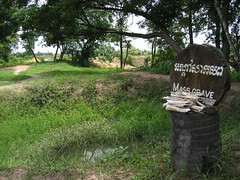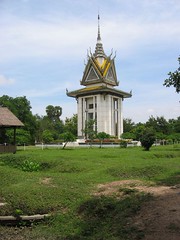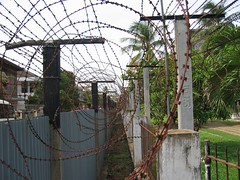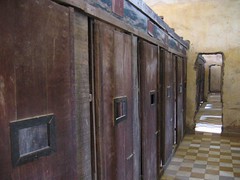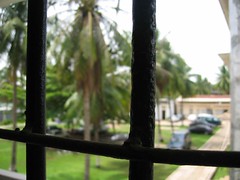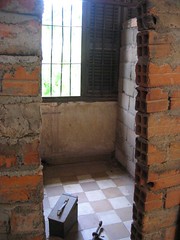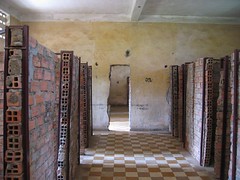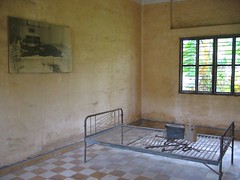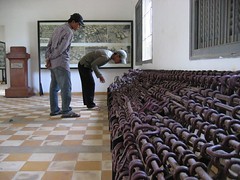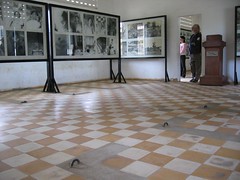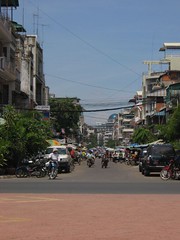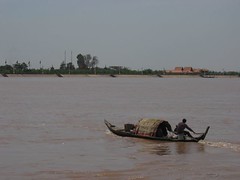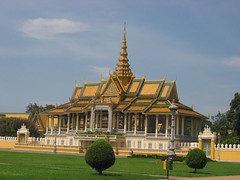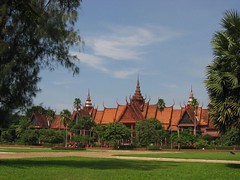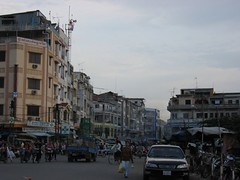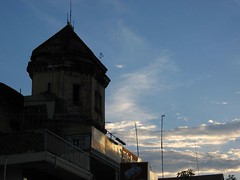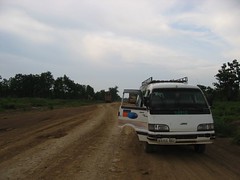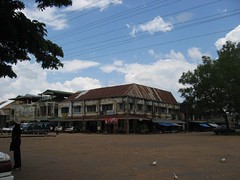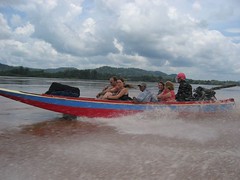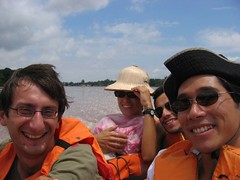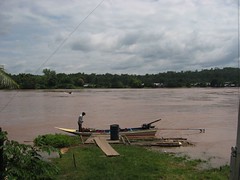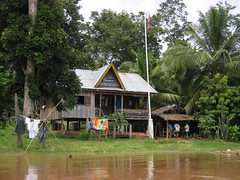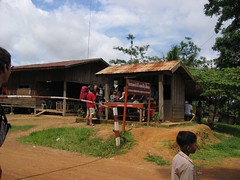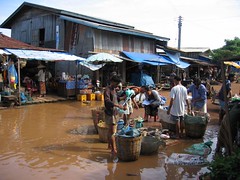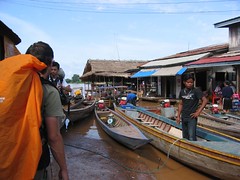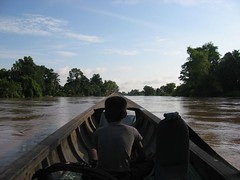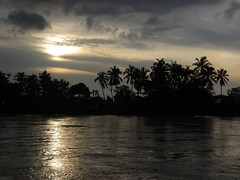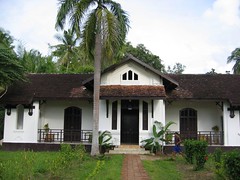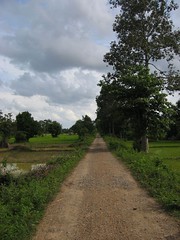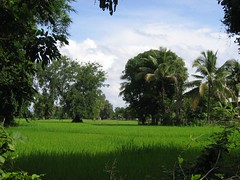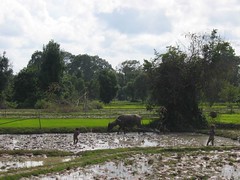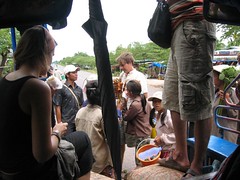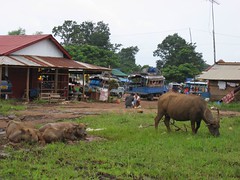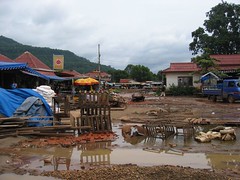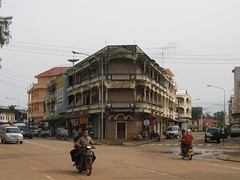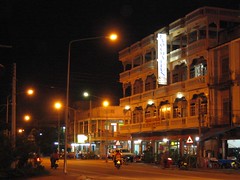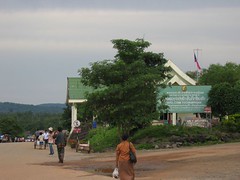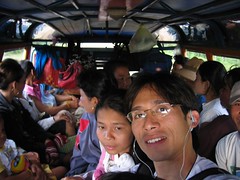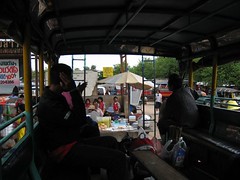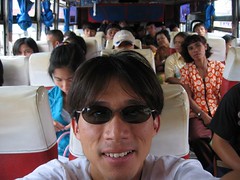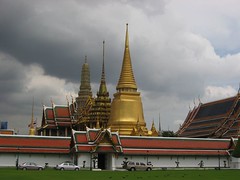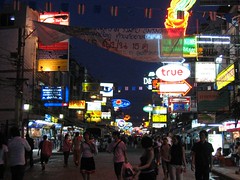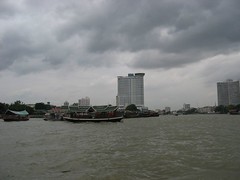I'm in Saigon now! This is a much more developed city than Phnom Penh or Vientiane. It reminds me more of Taiwanese or Malaysian urban areas. Interestingly, the red and yellow flags of the communist party are everywhere (hammer and sickle flags), much more than in Laos, where they seemed to be isolated to government buildings. The streets are narrow and traffic is tight. They say the key is to walk slowly and make eye contact with the drivers, oh and to watch out for the motorbike thieves.
I've got a day and a half to rest up. My buddy, Rob, is flying in tomorrow night!
a travelogue for a solo cross-country motorcycle road trip from Tampa, Florida to San Diego, California in 2008 and an overland attempt from Singapore to Morocco from November 2004 to August 2006
Thursday, August 25, 2005
Saigon
Wednesday, August 24, 2005
"And it's one, two, three...what're we fightin' for?"
"...You know I don't give a damn, next stop is Vietnam!"
I'm headed to 'Nam tomorrow morning, Saigon to be exact. Phnom Penh -- what an interesting city. I visited the US Embassy a couple days ago and spent an hour watching the interesting folks that stepped up to the window. There were a lot of engaged couples who had been introduced through acquaintences back in the States and had just met face-to-face in the past month. Very interesting, indeed. Ah, love, 'tis a wonderful and strange thing. Well, mostly strange, anyways...
I visited the Foreign Correspondent's Club yesterday and enjoyed dinner with a nice view of the Tonle Sap and the riverside drive in the evening. I have to admit that I have not been too bowled over by Cambodian cuisine, but I think it's been ruined by a decade of civil war and poverty. It's like a less spicy version of Thai food.
I find myself arguing with mototaxi drivers over the agreed fare of rides around this town on half of my trips. It's a con game they play because I think they're able to tweak a little more money from tourists. Not me. I haven't budged at all, and they scream and howl and cry, and gather other Cambodians around me to complain about me, but I am totally immune to that
sort of treatment. I know I'm paying twice what the locals are paying already. I find a secret satisfaction when I walk away and they're displeased. I haven't felt like this since Indonesia.
Tuesday, August 23, 2005
Mass graves
The Killing Fields at Choeung Ek
Torture room
S-21
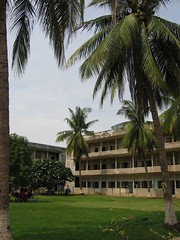
I visited s-21, the main "interrogation center" used by the Khmer Rouge government. It was a place of ruthless and pointless torture during Pol Pot's mad reign (1975-79). This place was a school that was converted into a place of pain an suffering. Under the Khmer Rouge, it is estimated that up to 1.8 million people were disappeared.
The Khmer Rouge
In 1975-79 Cambodia, then known as Democratic Kampuchea, was lead by Pol Pot and the Khmer Rouge, a Maoist peasant-worker communist society, that resulted in massive genocide and ethnic cleasning in Cambodia. One of the horrifying results of this regime were the mass graves known as "the Killing Fields" (check out the movie of the same name). Under the Khmer Rouge, the date was set back to Year Zero and people's identities were washed away. They wanted to raise a society washed clean of everything before it (and anything that could pose a threat to their power), so they brainwashed the children and turned them against their families. Anyone with any education that could pose a threat to the Khmer Rouge was sent to prison, interrogated, tortured, and summarily killed. Security Prison 21 (S-21) was the main interrogation center and prison during the Khmer Rouge, and I visited it today along with the Killing Fields.
I have been reading a book about Pol Pot and the Khmer Rouge, and it is frightening to think how such a regime could take hold and how a population could turn on its own. It is especially frightening because Pol Pot's regime appears to have been fueled by the same foreign policy that has been practiced in Latin America and the Middle East. When I read the few confessions by the Khmer Rouge and workers at S-21, I immediately wondered if such a place might exist in our time. Strangely, and I am embarrassed to admit this, I thought of the detention center at Guantanamo Bay, some place far away from the press and eyes of the people. At the same time, I realize that it was the withdrawl of foreign forces from SE Asia that allowed Pol Pot's regime to proliferate, and the years of terror only ended when Vietnam invaded Cambodia. What is left, however, is a generation still bears the scars of genocide.
Tonle Sap River
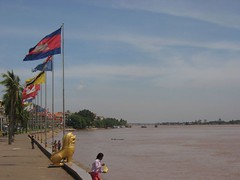
The Tonle Sap river connects Tonle Sap ("The Great Lake") to the Mekong at Phnom Penh. This massive freshwater lake (the largest in SE Asia) is about 1300 sq km in the dry season and during the rainy season goes up to 13000 sq km. The Tonle Sap river flows upstream (headed north) during the rainy season and reverses at the end of the rainy season, draining the lake.
National Museum
The road to Kratie
Stung Treng
Hold on to yer hats!
Cambodian immigration office
Getting off the boats at Ban Nakasang
Auberge Sala Don Khon
Road to Don Khon
Munching away
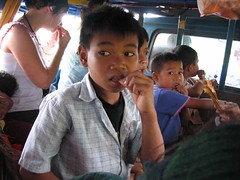
These kids were awesome. They used their fingers to eat everything, rolling a ball of sticky rice with their fingers and popping it into their mouth after a morsel of meat. They were also eating some hardboiled eggs that looked like they had chicken embryos inside, or else they had been filled with some other meat. They expertly freed lotus seeds from the pods, shelled them, and popped them in their mouths. I found it hypnotic.
Noontime lunch break
Mud everywhere
Evening in Pakse
Crossing into Laos
Waiting at the bus station in Philbun
The Grand Palace
The giant reclining Buddha
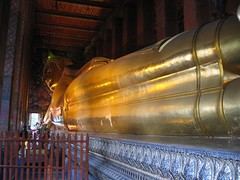
This statue is enormous -- 45 meters long and 5 meters high. It is at Wat Pho in Bangkok. The temple was constructed around it.
So this is the position the Buddha was in before he attained enlightment, which is to say, before he reached nirvana, which is to say, before he DIED OF STARVATION. Yet he is always smiling. What a contrast to Christianity with Jesus looking pained. Is this reflective of the always-smiling Asian or a reflection of optimism. Or maybe neither.
Nana Plaza
"Tell 'em a hookah-smoking caterpillar..."
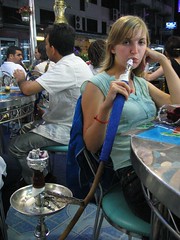
Soi 3 off Sukhumvit Road has a bunch of Egyptian, Indian, Pakistani, and North African restaurants. We checked out Neferiti, an Egyptian place. After stuffing ourselves on naan bread, Syrian salad (suspiciously similar to tabouli), hummus, lamb, and curry, we tried smoking a hooka: flavored coals placed on top of the hooka cooled through the water pipe. You're not supposed to inhale, and it doesn't give you a high. It's just a nice-smelling apple-flavored smoke (in which I quickly lost interest).
Traffic on the river
The Skytrain
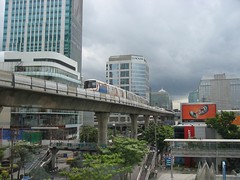
Bangkok's public transportation has, along with a subway, tuk-tuks, taxis, boats, and buses, the skytrain, an elevated train which can speed you from place to place without the hassle of being stuck in traffic. Rides cost from 25 cents to a dollar, but for $2.50 you can have an all day pass and watch the city glide by in air-conditioned bliss.
I ended up taking all four methods of transportation, most notably using a taxi (80 cents) to get to and from the hotel to the skytrain station (about 1 km away).
